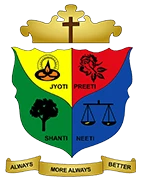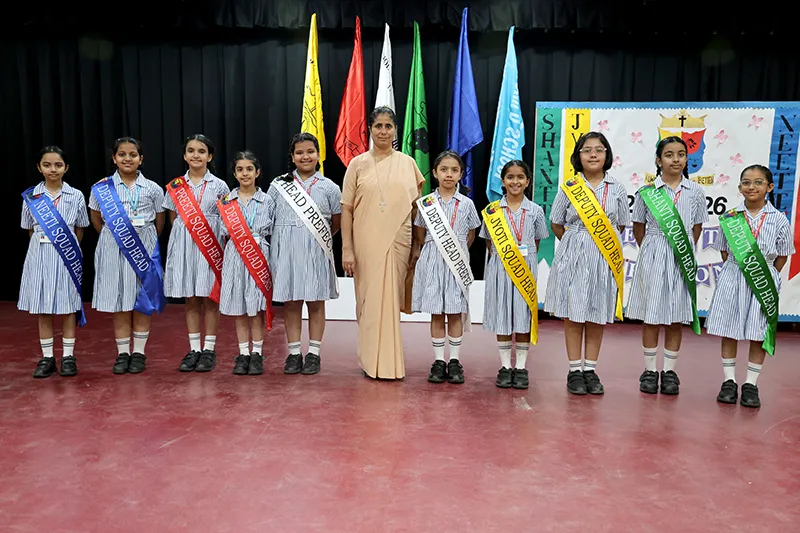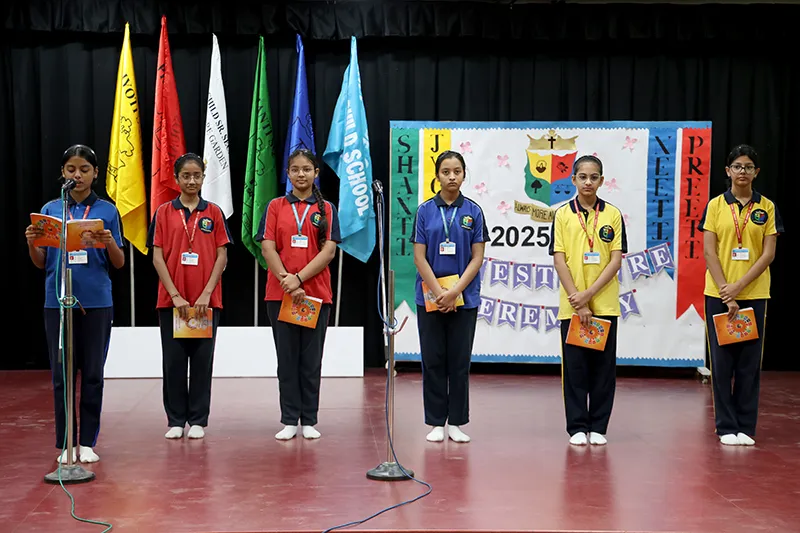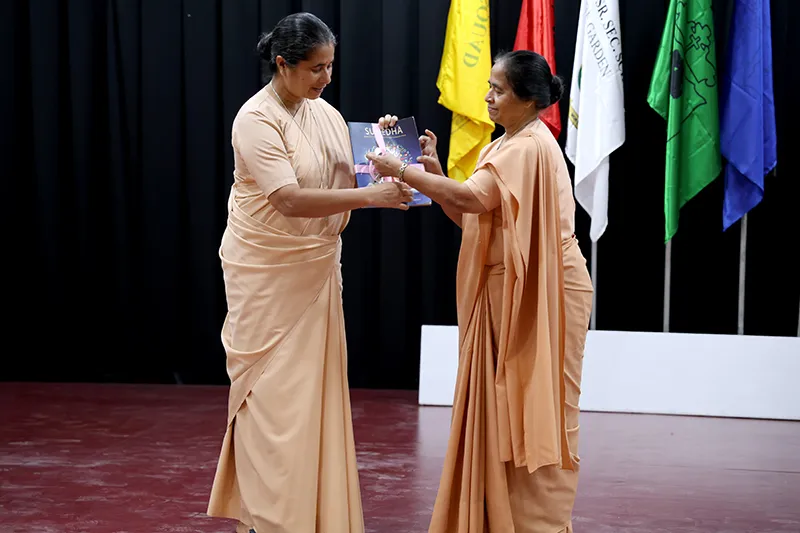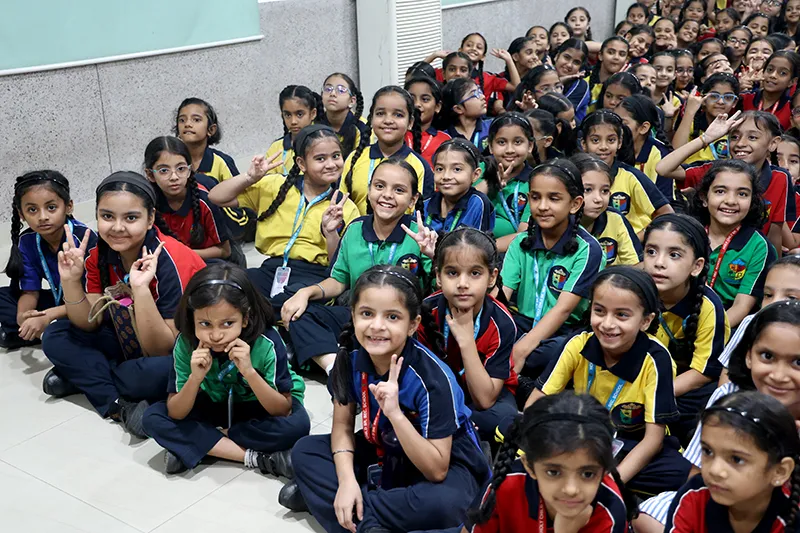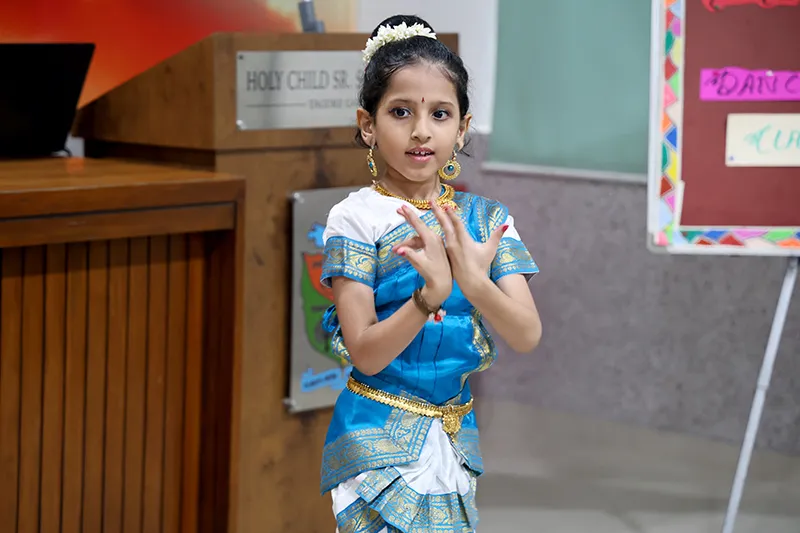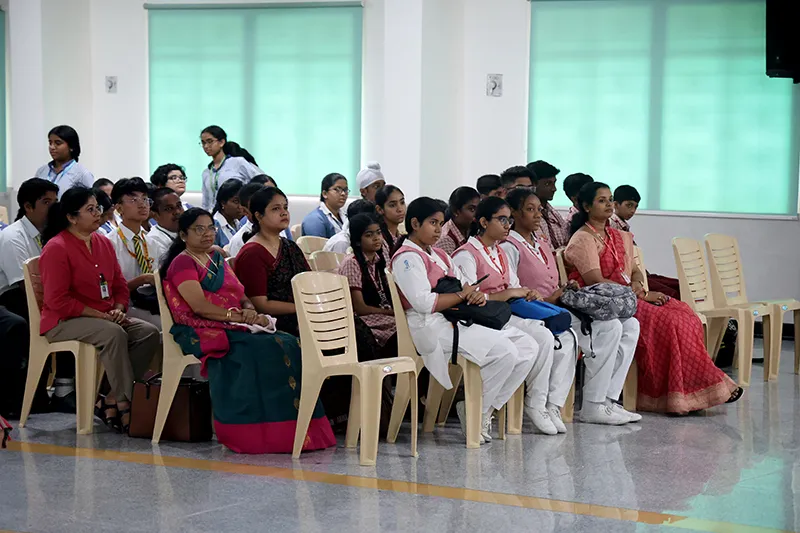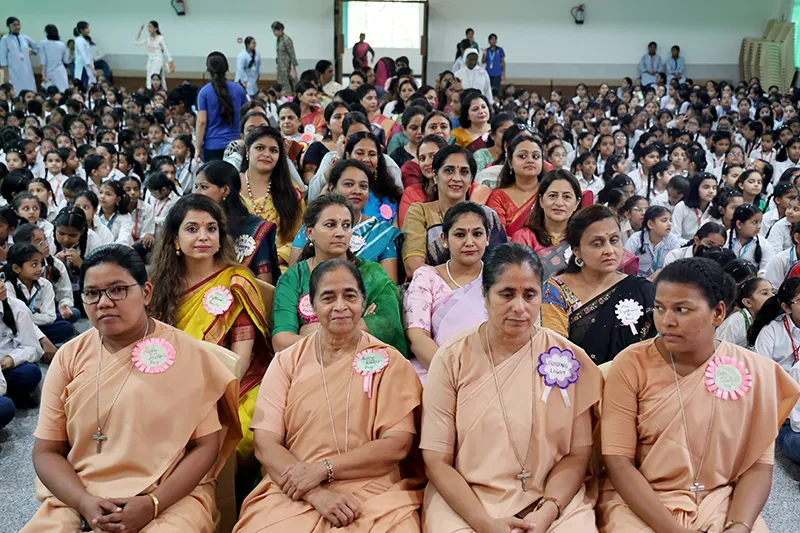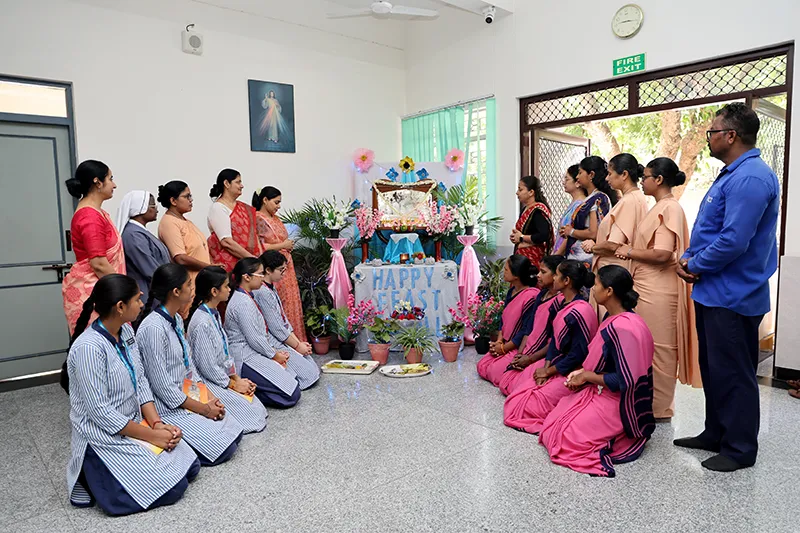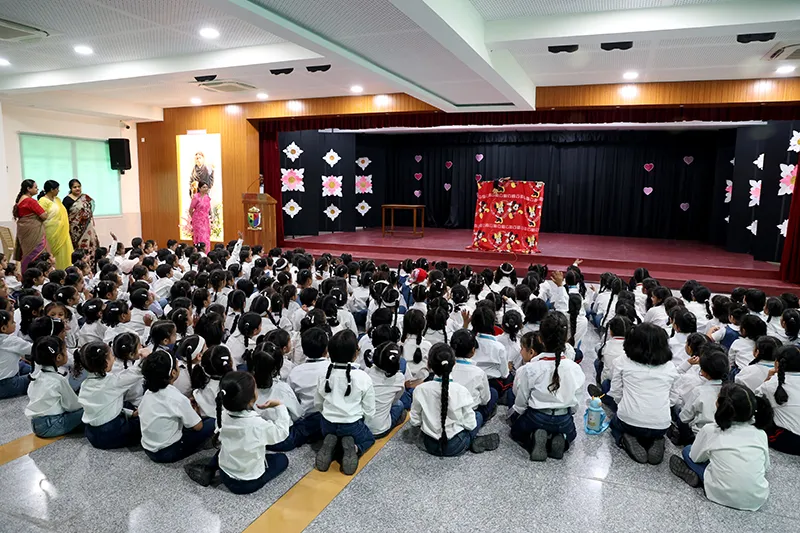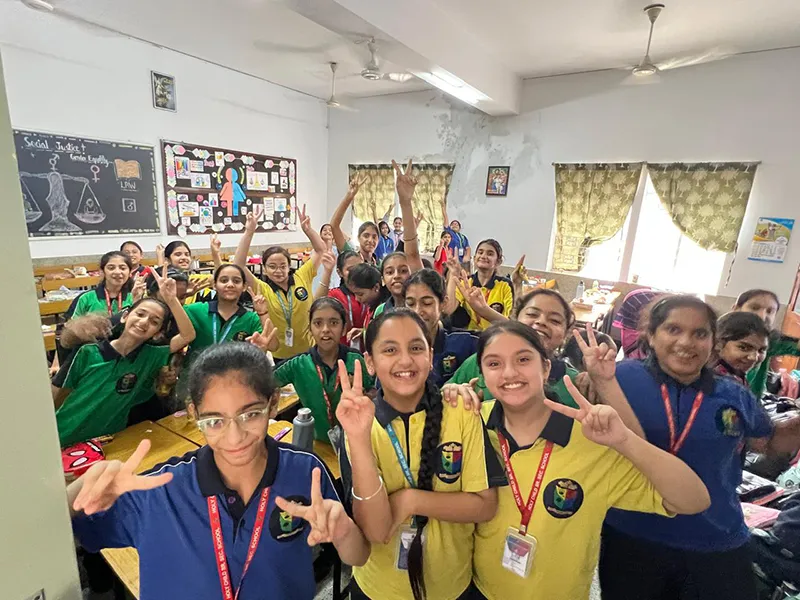
School Policies

Holy Child Sr. Sec. School, Tagore Garden, is committed to providing a safe, secure, and respectful learning environment for all students and employees. The institution follows all the below mentioned policies with regard to child and staff protection.
SCHOOL RULES
- Every student should bring the school diary daily.
- Pupils should be in the school premises at least five minutes before the school prayer or assembly.
- Pupils are required to put in 90 percent of attendance. Leave of absence is granted only on prior written application from parents except in case of unforeseen circumstances.
- Repeated absence without leave written or absence for more than 6 consecutive days renders a student liable to have her name struck off the rolls.
- Students are expected to attend the classes on the last working day before the start of the vacation and also the opening day after the vacation.
- Leave will not be granted for absence from school prior to a Test /Examination.
- The students are strictly forbidden to use any make-up, bleaching and colouring of hair, mehndi, nail polish and any other accessories than the prescribed uniform. The offenders will be fined as decided by the school.
- No items will be accepted at eh school counter or gate.
- Cell phones, cameras and any electronic gadgets are strictly forbidden.
- The green jute bag prepared by the school is to be used in place of polythene bag/ plastic which is prohibited in the school premises.
- No book (other than text books or library books) magazines or papers should be brought to the school without the Principal's permission.
- No collection for any purpose what so ever may be taken without the prior permission of the Principal.
- All the students must speak in English in the school premises.
- Enrolment to Holy Child School implies on the part of the pupils' and parents' willingness to comply with requirements and regulations of the school.
RESPONSIBILITIES OF THE DISCIPLINARY COMMITTEE
- Detecting and examining some behavioral problems common among the students.
- Interacting with misbehaving students and conveying the negative effects of bad behaviour on their life.
- Encouraging good behaviour amongst students and rewarding points in the school diary those with good conduct.
- Taking suitable action when required towards students' misconduct.
GENERAL RULES AND REGULATIONS:
- Students should treat school staff with respect at all times and be courteous to fellow students.
- Students will refrain from damaging any form of school property. The school reserves the right to be compensated by the student for any such damages.
- Students will refrain from littering and keep the school premises clean.
- Unacceptable behaviour including but not limited to irregular attendance, academic dishonesty, and neglect of homework, disruptive behaviour, loitering and disrespectful behaviour towards staff or fellow students will result in serious disciplinary action.
- Any form of bullying or ragging will result in a disciplinary committee review and could result in expulsion with a negative conduct certificate.
- Any misbehaviour or violation of school discipline will be dealt by the disciplinary committee and corrective action will be taken. In extreme cases parents will be called in to discuss the child's behaviour and may lead to suspension or expulsion from the school.
- The medium of instruction is English and students are expected to communicate in English at all times.
- It is compulsory to bring the school issued ID card to school every day. Not bringing the ID card could result in the child not being allowed into the school premises.
- For safety and security, parents should refrain from sending money with their child without specific written notice from the school.
- For safety and security, parents should refrain from sending valuables (like expensive jewellery, electronic items, etc.) to school
Entering the classroom without uniform is strictly prohibited - It is impermissible to bring telecom machines or cellular phones to the school premises. For urgent calls, students can contact their parents through the school administration.
- Students are allowed to buy from the school canteen during breaks only.
- Student are not allowed to leave the classroom without taking permission from the teacher.
- After breaks, students must go directly to their classrooms.
- Students accompanied with their teacher must line-up quietly and properly when they leave their classroom to Science Lab or P.E periods.
- If the subject teacher does not reach his lesson on time or is absent, students must wait inside the classroom.
- Students are not allowed to leave their classroom to the playground if they have a free period. Substitution should be given to a teacher.
- Students must bring all their required books, copybooks and pencil cases according to their timetable.
- Homework assignments must be done as assigned on time.
- Students are not allowed to touch or keep dangerous or harmful objects.
- Students are not allowed to throw objects around the school.
- Students should respect other's feelings - no teasing, name calling, swearing, etc. bullying in any form is not allowed in the campus.
- Students should respect other's person - no rough play, fighting, bullying, threats, harassing, etc.
- Students should respect other's property - no theft, vandalism, etc.
CLASSROOM RULES
- Arrive to class on time with the necessary equipment.
- Listen to teachers or other students without interruption.
- Complete all assignments on time.
- Treat the teacher and other students with respect.
- No eating or drinking is allowed in class (water is acceptable.)
- Keep hands and feet to yourself.
- Respect the property of the school. Don't draw on walls or tables.
- Respect the rights and property of others.
- Act in a safe and responsible manner.
DRESS CODE
- The wearing of chains is not permitted.
- Short trousers are not permitted.
Consequences for Dress Code Violation:
- 1st Offense: Verbal warning is issued
- 2nd Offense: Student is charged a fine
- 3rd Offense: Parents are called to the office.
MOBILE POLICY
- Mobiles are prohibited within the school premises.
- Parents should discourage their wards from bringing mobile phones to schools.
- If a student is found using a mobile phone, for any purpose, the phone will be confiscated from the pupil.
- As a general rule, students are not allowed to use the school telephones except for emergencies.
To use the telephone, students should request permission from the Students' Counsellor or their Teacher.
LOST AND FOUND
A lost & found property box is located near the staircase of wing A. If a student finds something, he/she is requested to put it in the box. So, the student is advised to refer to the Students' Counsellor to check his/her missing properties.
THE CODE OF STUDENT CONDUCT:
The Students Should:
- Be proactive in promoting and working towards making school a positive, supportive, safe and welcoming place for all students and teachers.
- Be respectful and courteous to fellow-students' parents, guardians and teaching and non-teaching staff.
- Be knowledgeable about discipline policies regulations and rules.
- Follow school rules and contribute to a positive school climate by behaving appropriately even when not specifically asked to do so.
- Make every reasonable effort to participate actively in the activities of the school.
- Recognize how their conduct affects other students and school as a whole and make every effort to restore relationship affected by their conduct.
- Share ideas and strategies for improving school climate and school discipline practices.
The Constitution of India guarantees several rights to children and enables the State to make provisions to ensure that the tender age of children is not abused. Child Abuse was and continues to be, one of the most heinous crimes designed and perpetuated by human beings against some of the most vulnerable and defenseless sections of the community. Globally, it has been recognized and seen as a particularly burdensome challenge. According to the World Health Organization, "Child maltreatment, sometimes referred to as child abuse and neglect, includes all forms of physical and emotional ill-treatment, sexual abuse, neglect, and exploitation that results in actual or potential harm to the child's health, development or dignity. Within this broad definition, five subtypes can be distinguished - physical abuse; sexual abuse; neglect and negligent treatment; emotional abuse; and exploitation".
Types Of Abuse
Physical Abuse : Includes hitting, kicking, punching, biting, burning, shaking, drowning, smothering and giving drugs or alcohol (includes corporal punishment)
Possible Symptoms :
- Frequent injuries or unexplained bruises, fractures, welts, burns or cuts
- Depression and anxiety and/or aggression and violence.
- Problems with relationships and socializing / distant and withdrawn.
- Wears inappropriate clothing to cover up injuries, such as a coat on warm days.
- Running away
- Sleeps in Class /appears drowsy
Emotional Abuse : Includes threats, humiliation, sarcasm, degrading punishments, undermining confidence
Possible Symptoms :
- Possible delayed physical, emotional and mental development.
- Being unable to play or socialize well with others
- Fearful of making mistakes
- Self-harm
- Sudden speech disorders or neurotic behaviour such as rocking
- Low self-esteem / confidence
- Crying inconsolably
Sexual Abuse : Includes kissing, touching genitals or breasts, vaginal or anal intercourse, oral sex, and encouraging to look at pornography, trading grades for sexual favours.
Possible Symptoms :
- Aggressive behaviour, risk taking and missing school or running away.
- Sleep problems and bed-wetting or soiling.
- Negative thoughts / not looking after themselves / low self esteem
- Displaying sexually inappropriate behaviour
- Anal or vaginal soreness
- Unexplained bleeding from private parts.
Substance Abuse : Includes intake of Psychoactive /alcoholic /narcotic substance /tobacco or engage in buying or selling of any above-mentioned substance.
Possible Symptoms :
- Aggressive behaviour, risk taking, missing school.
- Stealing
- Low self-esteem/ confidence
- Unable to socialize well with others
- Day dreaming, lethargic
Neglect : Includes lack of food, medical attention, supervision, clothing etc.
Possible Symptoms :
- Delayed development
- Poor hygiene, unwashed clothes or inadequate clothes
- Untreated medical conditions
- Being hungry or tired all the time
- Missing school or difficulties with school work
- Poor self esteem
- Withdrawn and difficulty making friends and/or anti-social behaviour
A child needs protection from people with unhealthy attitude present in the school campus. These include other School students, administrators, teachers and rest of the school staff (i.e., cleaning agency workers, office staff, security workers, etc). Child protection can be ensured through appropriate action against bullying; corporal punishment; any sort of physical, verbal or sexual abuse and indiscipline, violence or substance abuse. Therefore, Child protection policy includes sub-policies namely-
- Anti-Corporal Punishment Policy
- Anti-Bullying Policy
- Anti-Cyber-Bullying Policy
- Anti-Tobacco and Substance Abuse Policy
The Right of children to Free and Compulsory Education Act (RTE, 2009), clearly states that no child shall be subject to "physical punishment or mental harassment" in schools. Those officials that contravene this provision shall be liable for disciplinary action under service rules applicable to them.
It is not easy to define corporal punishment as it involves humiliation and insult which a child feels as a subject. Considering the millions of ways in which punishment is perpetrated on children in contemporary times, it is impossible to exhaust all the forms of insinuations and violence. However, following behaviour has been categorically put under Anti corporal policy of the school.
Physical punishment is understood as any action that causes pain, hurt/injury and discomfort to a child, however light. Examples of physical punishment include but are not restricted to the following:
- Causing physical harm to children by hitting, kicking, scratching, pinching, biting, pulling the hair, boxing ears, smacking, slapping, and spanking or with any implement (cane, stick, shoe, chalk, dusters, belt, whip, giving electric shock etc.)
- Making children assume an uncomfortable position (standing on bench, standing against the wall in a chair-like position, standing with schoolbag on head, holding ears through legs, kneeling etc.)
- Forced ingestion of anything (for example: washing soap, mud, chalk, hot spices etc.)
- Detention in the classroom, library, toilet or any closed space in the school.
Mental harassment is understood as any non-physical treatment that is detrimental to the academic and psychological well-being of a child. It includes but is not restricted to the following:
- Sarcasm that hurts or lowers the child's dignity; Calling names and scolding using humiliating adjectives, intimidation;
- Using derogatory remarks for the child, including pinning of slogans;
- Ridiculing the child with regard to his/her background or status or parental occupation or caste;
- Ridiculing the child with regard to his/her health status or that of the family - especially HIV/AID Sand tuberculosis;
- Belittling a child in the classroom due to his/her inability to meet the teacher's expectations of academic achievement;
- Punishing or disciplining a child, not recognizing that most children who perform poorly in academics are actually children with special needs. Such children could have conditions like learning disability, attention deficit hyperactivity disorder, mild developmental delay etc.
- Using punitive measures to correct a child and even labelling him/her as difficult; such as a child with attention deficit hyperactivity disorder who may not only fare poorly in academics, but also pose a problem in management of classroom behaviours;
- 'Shaming' the child to motivate the child to improve his performance and
- Ridiculing a child with developmental problems such as learning difficulty or a speech disorder, such as, stammering or speech articulation disorder.
Discrimination is understood as prejudiced views and behaviour towards any child because of her/his caste/gender, occupation or region and non-payment of fees or for being a student admitted under the25% reservation to disadvantaged groups or weaker sections of society under the RTE, 2009. It can be latent; manifest; open or subtle. It includes but is not restricted to the following:
- Bringing social attitudes and prejudices of the community into the school by using belittling remarks against a specific social group or gender or ability/disability;
- Assigning different duties and seating in schools based on caste, community or gender prejudices for example, cleaning of toilets assigned by caste; task of making tea assigned by gender); admission through 25% reserved seats under the RTE; or non-payment of any prescribed fees;
- Commenting on academic ability based on caste or community prejudices and
- Denying a facility like library books or uniforms or sports facilities to a child or group of children based on caste, community, religion or gender.
As a staff member working in Holy Child Sr, Sec, School, which is committed to the protection of children from all forms of abuse, all the staff members of HCS adhere to the code of protective behaviour policy to be signed at the time of joining the institution along with constant upgradations and training to ensure safety of all the students.
The staff members, individually, agree to abide by the following rules and regulations listed below which are drawn up by the institution in this regard.
Name of the Teacher: ____________________ Designation: _________________ Date: ___________
Accordingly, I state that,
(i) I Shall always Ensure that:
- I am open and not secretive about my activities associated with my service in the Institution.
- I will interact with every child/young person in a manner which demonstrates respect, dignity, integrity, empathy, understanding and patience.
- I will always adopt socially appropriate adult behaviour towards children and young persons, which reflects the capacity to listen, understand and be respectful towards others.
- There will be other professional adults to supervise me, whenever there is a sleep over or a stay in a hotel/hostel during excursions or educational travels.
- The doors of the room that I am using are always open or visual access is always maintained, when I am alone with a child or young person.
- While being available to children in discharging my duty in the institution, I will maintain the professional boundaries of relationship with them.
- Any physical touch will be in response to the need of a child and never of an, inappropriate kind whatever be the apparent need.
- I will respect any resistance to involvement from a child or young person, in any activity that is not part of the legitimate service of the institution.
- My relationship with children will be prudently governed respecting the age and developmental stage of a child or young person.
- I will never touch a child's or young person's buttocks, genitals or breasts, unless I am a certified medical practitioner and only for performing a legitimate and necessary medical action.
- I will respond to each child or young person as a unique creation of God, who has the right- to determine his/her own future.
- I will seek to establish a caring, protective and respectful relationship with each child or young person.
- I will be alert about the vulnerability of certain groups of children and young persons to being isolated, bullied or hurt.
- I will give priority to extend care, safety and protection to every child or young person through proper supervision while on duty or when necessary.
- I will physically restrain a child or young person only when there exists a danger to the individual or to other individuals in the area.
- I will announce myself if legitimate business of the Institution, requires me to enter any area of privacy for children or young persons, before entering.
- I will maintain conditional confidentiality about information known to me about a child or young person.
- I will interact with a child or young person, professionally in my official capacity, on the internet and social networking sites or while phoning or texting.
- I will comply with the principles and standards of Indian and international child protection policies, labour laws and conventions.
- I will be vigilant and attentive to any harm towards children and young people and shall immediately report any concern I have of the same to the Child Protection Officer, of my Institution.
- However, sometimes when it may be necessary to conduct physical checks of the students in the institution for cell phones and other contraband material, I will do it only when asked for or with permission and following all norms of touching (avoiding those areas of the body restricted to touch).
- I will comply with all the procedures of the 'CBCI Child Protection Policy and Procedures' implemented in the institution.
- I will refer all media queries to the spokesperson designated for the task, and give no other comments.
- I will speak up on any genuine case of abuse behaviour to the proper persons concerned viz. to the Head of the Institution/Child Protection Officer of the Institution (Coordinator) no matter what, but without gossip mongering.
- I will comply with the dress code prescribed in the institution while on duty and if there is no specified dress code, I will always come modestly and neatly dressed.
(ii) I Shall always Avoid:
- Engaging in behaviour that is intended to shame, humiliate, belittle or degrade especially children and young persons and the institution.
- Using inappropriate, offensive, discriminatory, vulgar or abusive language when speaking especially with children or young people.
- Swearing in the presence of children or young persons to prove my point of view.
- Doing things of a personal nature that a child or young person can do by himself/herself, such as assistance at the toilet or changing clothes.
- Entering any area of privacy for children or young people, unless legitimate business of the Institution or any accident required me to.
- Taking children or young people that I am professionally engaged with, to my own home/hotel, or sleeping in the same room or bed with any of them.
- Slapping, hitting or physically assaulting a child or young person.
- Having recourse to or using disciplinary means, which are physically or emotionally derogatory to a child or young person.
- Engaging in any sexual conversation or discussing sexual activities, unless part of a legitimate lesson and discussion approved for teaching sexuality or biology related issues.
- Indulging in any manner of activities that are, or could be interpreted to be, aimed at any type of sexual relationship with a child or young person.
- Developing a sexual relationship or one that may be deemed exploitative or abusive in nature with children or young people.
- Indulging in behaviour with children or young people, that leads to close physical contact, unless it is an unavoidable part of a structured sports activity or outdoor games.
- Performing medical/physical examinations of children or young persons, unless it is my legitimate professional duty or a medical emergency.
- Showing sexually oriented or inappropriate printed or digitalized material, such as magazines, videos, films, MMS etc. to children or young people or having them on the premises of the Institution or in my possession when involved in an activity in the Institution or outside of it. 15. Behaving provocatively or inappropriately with a child or young person.
- Exposing areas of my body considered private, in an inappropriate manner in the presence of children or young people.
- Condoning or participating in behaviour of children or young persons that is illegal, unsafe or abusive.
- Acting in a manner that shows unfair and differential treatment of particular children or young persons.
- Taking photograph or video recording of children or young persons, without their consent and that of their parents or guardians.
- Holding, kissing, cuddling or touching a child or young person in an inappropriate, unnecessary or culturally insensitive way.
- Seeking to make contact and spend private time with any child or young person even for teaching/coaching etc. outside the legitimate time allotted for that purpose, except with express consent of the head of the institution and the parents.
- Interacting with children or young persons I am professionally involved with, over the internet or on the social media on a regular basis.
- Using any officially or individually owned computer, mobile phone, video or still camera inappropriately, or accessing of websites that are illegal or have inappropriate content for the purpose of exploiting or harassing children or young persons.
- Hiring minors as domestic labour or cooperating with others to hire minors as domestic labour.
- Transporting children or young persons, without the permission of their parent or legal guardian, except when directed by the head of the institution or his/her delegate in the event of an emergency or academic or sports related activity with proper accompanying documentation.
- Using, possessing or being under the influence of illegal drugs or alcohol or tobacco products when in the presence of or while supervising children or young persons.
- Supplying alcohol or illegal drugs or tobacco products to children or young persons.
- Discriminating against a child or young person on the basis of their race, colour, gender, sexual orientation, language, status, ethnicity, nationality, cast, religion etc.
- Receiving personal gifts/money/services from individuals partaking of the services of/for or connected with the Institution, or as a condition for any service asked for because of any connection with the institution.
- Using negative enforcement strategies with children or young people, such as physical punishment, derogatory or offensive comments, labelling, belittling, teaching, social exclusion, unequal competition or unequal comparisons or setting them up in situations to cause conflict among children.
- Any act that can be construed to be a form of what is commonly referred to as 'ragging' or nagging behaviour towards children.
- Neglecting to take action when a child or young person is in real need.
- Letting false allegations made by a child or young person or about a child or young person, go unchallenged.
- Being negligent by not speaking up for the rights of any person, especially children and youth who are being abused in any way.
- Making any report that is aimed at 'getting even' or 'fixing' another individual and which can be termed as frivolous or vexatious in nature.
Bullying is strictly prohibited inside the school premises and no such act will go unnoticed or unpunished. The school has created a friendly and optimistic environment where learning can take place peacefully. There should be a trusting and respectful relationship among students.
School provides a confidential way for students to report about any incident which is of concern to them. Structures and procedures have been established to provide accessible, confidential, secure and effective means of reporting incidents of bullying, for victims and for bystanders who are aware of it taking place and to identify and manage incidents of bullying, including appropriate counselling and sanctions/ punishments on those engaged in bullying. The school is also adhering to the Directorate of Education guidelines of 'Prevention of Bullying and Ragging in schools' No. DE.23 (514)/Sch.Br./2018/ 1790 dated 04.01.2019'.
PLAN OF ACTION
- Precautionary Measures
Conduction of workshops for imparting awareness regarding bullying, sensitization workshops to educate and develop the understanding among students, staff and parents about the problem and effects of bullying. Adherence to child rights and protection policies. Initiatives to provide Life Skills Education, Value Education, Human Rights, Gender Sensitivity, Self-Esteem, Empathy, Interpersonal Communication, coping with stress and emotions, dealing with anger, and resisting peer pressure are conscientiously taken up in the activity periods. These can take the form of role plays, street theatre (nukkad-natak), group-discussions, debates, special assemblies in schools, poster competitions, etc. A complaint/suggestion box is also installed in the school and the feedback/suggestion received is monitored regularly. The necessary issues are discussed and appropriately addressed.
- Intervention Measures
In case of incidence, the following action measures are implemented to deal with bullying. Separate measures are taken for the bully and the victim.
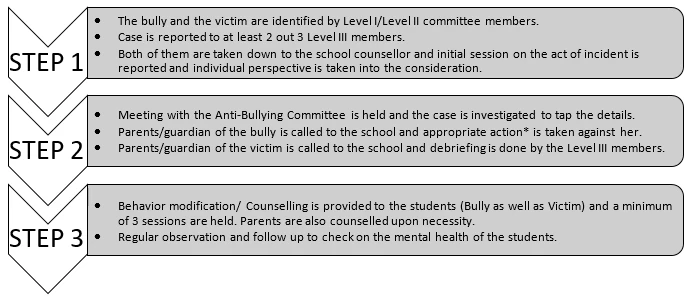
ACTION IN CASE OF SECURITY BREACH BY STUDENT
- First time offenders: Oral/written warning is given and parents are called to the school and informed about the incident. Depending upon the gravity of the incident, suspension from attending classes/school for a specified period can also be imposed followed by individual/ group counselling.
- Second time offenders: Withholding or cancelling the results, imposition of fine upto a specified amount, dismissal/expulsion/rustication from school followed by individual counselling upon requirement.
Use of computers in schools for Teaching, Evaluation, Storage, Manipulation and Administrative transactions of information is a common practice due to its manifold advantages. Undoubtedly, this vital and useful tool needs to be utilized to the optimum but while doing that, we must not lose sight of the fact that computers and computer networks can cause info leakages in numerous ways. Unless we are sensitive to the vulnerabilities of this tool and utilize it with utmost security consciousness by adopting correct practices and adhering to laid down security procedures, this versatile and extremely useful automation tool can turn out to be the greatest curse.
GUIDELINES
One of the major threats to our students is Cyber Bullying, which means bullying with technology or any electronic communication. This includes transfer of any type of unethical or unwanted signs, signals, writing, images, sounds, data or intelligence of any nature transmitted in whole or in part by such things as electronic mail, internet communications, instant message, text message or facsimile.
Cyber-bullying includes-
(i) The creation of a web page/blog in which the creator assumes the identity of another person or
(ii) Knowing the impersonation of another person as the author of posted content or messages, if the creation or impersonation is a violation under the law.
Cyber-bullying also includes the distribution by electronic means of a communication to more than one person or the posting of material on an electronic medium that may be accessed by one or more persons, if the distribution or posting is a violation of the law. It is the responsibility of every student, parent and employee of the school district to recognize acts of bullying, cyber-bullying and retaliation. Any student who believes that he or she has been the victim of bullying, cyber-bullying or retaliation is advised to report immediately to his or her teacher or principal. Students, parents and members of the school staff (including but not limited to educators, administrators, school nurses, cafeteria workers, custodians, bus drivers, coaches, advisors, advisors to an extracurricular activity, or paraprofessionals), who witness or become aware of bullying.
This policy exists to ensure that all HCS staff and students follow certain basic rules with regard to internet use and use of IT in general. Its aim is to prevent students or staff coming to harm as a result of others accessing intolerant, extremist or hateful web sites. Also, it is here to protect students and staff from cyber risks. HCS has the right to monitor electronic information created and/or communicated by students or staff using school computer systems / equipment’s and networks, including e-mail messages and usage of the Internet.
1.1 CYBERSPACE :
1.1.1 It is a complex environment consisting of interactions between people, equipment’s, software services supported by worldwide distribution of information and communication technology.
1.1.2 Owing to the numerous benefits brought about by technology, the cyberspace is a common pool of resources used by students, citizens, businesses, critical information infrastructure and all stake holders.
1.1.3 Information Technology (IT) is one of the critical sectors that rides on and resides in Cyberspace.
1.1.4 We must provide a right kind of focus for secured computing environment and adequate trust and confidence in electronic transactions, software, services, devices and networks.
1.1.5 Cyberspace is vulnerable to a wide variety of incidents, whether intentional or accidental, manmade or natural and the data exchanges in the cyberspace can be exploited for nefarious purposes.
1.2 SAFELY USE OF INTERNET
1.2.1 Must receive permission from a member of staff before accessing the internet.
1.2.2 Must access only appropriate sites for their work; any attempt to bypass filtering system or access social networking sites or chat rooms will be with the permission of a teacher for a work-related item.
1.2.3 Must not claim to be representing the school in an official capacity when using the internet or e-mail or website privately.
1.2.4 Must not use any internet services to purchase goods or make any payments unless authorised otherwise.
1.2.5 As the internet allows you to do more and more online, it is extremely important to be aware of the dangers and how to stay safe.
1.2.6 Use social networks’ privacy settings so only your friends can see your information.
1.2.7 Never open an email from an unknown source – it may contain viruses that can harm a computer. And don’t access or use files without the permission of owner.
1.2.8 Don’t send pictures to strangers or view pictures that strangers send you.
1.2.9 Passwords should be kept private (except from parents).
1.2.10 Always use the two-factor authentication for email and other important logins.
1.3 STRATEGIES FOR RESPONSIBLE & SAFER INTERNET
- There’s no such thing as “private” online. Anything posted can be seen by or forwarded to strangers. Must know what’s okay to post. Teen years are full of self-expression and rebellion. Just make sure that your you know your rules about suggestive material or other content that may reflect poorly on you. This means no embarrassing or cruel posts, no hate speech or groups, no compromising pictures you wouldn’t want the whole world to see.
- Be a good digital citizen. Online cheating is still cheating and flagging inappropriate content isn’t tattling.
- Encourage critical thinking. You should ask “who posted this? Why?” Thinking this way will help you find trustworthy information, and it will also help you avoid online scams that deliver spyware and viruses directly to your home. You should also think critically about your own posts. Learn to ask yourself, “Why am I posting this? Who will see it? Could it be misunderstood?”
- Stay in safe neighborhoods. Just as you learn not to walk down dark alleys alone at night, you need to know how to avoid creepy places online.
- Review your own habits carefully. Parents are the ultimate role models. Keep channels of communication open.
- Better safe than sorry. Make sure you are comfortable telling your parents/teachers if anything menacing or cruel happens - - no matter what site you were on.
1.3.1 Never give out personal details like in messenger or in personal profiles.
1.3.2 Never give a friend’s details and never share your password with anyone and even enter it carefully, if someone is sitting near you.
1.3.3 Never meet up with anyone you befriend online.
1.3.4 Never open the emails \ attachments \ links coming from any unknown person.
1.3.5 Be careful while sharing your photos on social media or with anyone.
1.3.6 Never try to login as someone else and read their emails or access other data.
1.4 KEY POINTS FOR ONLINE CLASSES
1.4.1 Parents/Students/Guardians must not share class invites/ links with anyone who is not a part of the school or class or has not been invited by the teacher.
1.4.2 Parents/Students/Guardians must not take photos, screenshots, record videos/ audios of the virtual sessions.
1.4.3 All material shared on Microsoft Teams/Google Classroom or Meet is the school’s intellectual property and downloading/ circulating/ sharing of content without permission is strictly prohibited.
1.4.4 Staff, parents and students must keep their identity safe and not share google passwords or their identity with anyone. Staff, parents and students must ensure they sign out of each session completely after completion of the session.
1.4.5 Social media apps such as Snap Chat, Instagram, WhatsApp, or Facebook are not official, School-sanctioned channels of communication and must not be used for teaching and learning.
1.4.6 Parents/Students/Guardians should inform the Teacher/School formally, in case a student is not able to attend any session.
1.4.7 All users are required to be polite, respectful, and appropriate in their communications and must represent the school’s values in their interactions with others, this applies for written words and as well as tone of conversation.
1.4.8 The users(staff/students) must respect copyright and licensing laws with respect to software, information and other materials retrieved from the Internet.
1.4.9 Users must not indulge in cyber bullying and writing of unkind remarks on the walls of unsuspecting friends, sharing of pornographic material through social media and/or email.
1.4.10 The hacking and attempts at hacking the school personnel’s email accounts, network and any other school assets have been and will continue to be dealt with the necessary seriousness.
1.4.11 Report about abusive or illegal content or online bullying immediately to teacher or parents.
1.4.12 Don’t use other’s information to login and not even attempt to infect or in way to try to make someone else computer\device\credentials.
1.4.13 Using the secured & encrypted SSL-VPN for remote access.
1.5 ELECTRONIC CRIME (E-CRIME)
It occurs when computers, or any other electronic communication equipment or devices (such as mobile phones or the internet), are used to commit an offence, are targeted in an offence, or act as storage or communication devices in an offence.
TYPES OF ELECTRONIC CRIMES (E-CRIME)
1.5.1 Fraud & Financial Crimes: Computer fraud is dishonest misrepresentation of fact intended to cause loss. For example, bank fraud, identity theft, extortion, and theft of classified information.
1.5.2 Obscene or offensive content: The content of websites and other electronics communications may be distasteful, obscene or offensive for a variety of reasons. In some instances, these communications may be illegal.
1.5.3 Cyber bullying: content may be offensive in a non-specific way, harassment directing obscenities and derogatory comments at specific individuals focusing for example on gender, race, religion, nationality, sexual orientation. This often occurs in chat rooms, through newsgroups, and by sending hate e-mail to interested parties. Any comment that may be found derogatory or offensive is considered as Cyber bullying.
1.5.4 Threats: Advertisements promising unrealistic products/services (adware) and software that intentionally causes harm (Malware)
1.5.5 Cyber Terrorism: A cyber terrorist is someone who intimidates or coerces a government or organization to advance his or her political or social objectives by launching computer-based attack against computers, network, and the information stored on them.
1.6 IT DEVICES/RESOURCES :
They include (such as desktops, notebooks, and tablets), storage devices (USB and flash memory devices, CDs, DVDs, floppy disks, iPod, MP3 players), cameras (video and digital cameras and web cams), all types of mobile phones, gaming consoles, video and audio players or receivers (portable CD and DVD players), and any other similar electronic and storage technologies.
1.7 UNDERSTAND THE CYBER LAW
Section 2 (1) (nb) of Information and technology Act 2000 cyber security means protecting information, equipment, devices, computer, computer resource, communication device and information stored therein from unauthorised access, use, disclosure, disruption, modification or destruction;]
Section 2 (1) (0) of Information and technology Act 2000 "data" means a representation of information, knowledge, facts, concepts or instructions which are being prepared or have been prepared in a formalised manner, and is intended to be processed, is being processed or has been processed in a computer system or computer network, and may be in any form (including computer printouts magnetic or optical storage media, punched cards, punched tapes) or stored internally in the memory of the computer;
Section 2 (1) (r) of Information and technology Act 2000
electronic form" with reference to information means any information generated, sent, received or stored in media, magnetic, optical, computer memory, micro film, computer generated micro fiche or similar device; (s) "Electronic Gazette" means the
Section 2 (1) (t) of Information and technology Act 2000
"Electronic record" means data, record or data generated, image or sound stored, received or sent in an electronic form or micro film or computer-generated micro fiche;
Section 2 (1) (v) of Information and technology Act 2000
"Information" includes data, text, images, sound, voice, codes, computer programmes, software and data bases or micro film or computer-generated micro fiche
Section 43 of Information and technology Act 2000, If any person without permission of the owner or any other person Penalty for who is incharge of a computer, computer system or computer damage to network,— computer, computer system,
(a) accesses or secures access to such computer, computer system etc. or computer network;
(b) downloads, copies or extracts any data, computer data base or information from such computer, computer system or computer network including information or data held or stored in any removable storage medium;
(c) introduces or causes to be introduced any computer contaminant or computer virus into any computer, computer system or computer network;
(d) damages or causes to be damaged any computer, computer system or computer network, data, computer data base or any other programmes residing in such computer, computer system or computer network;
(e) disrupts or causes disruption of any computer, computer system or computer network;
(f) denies or causes the denial of access to any person authorised to access any computer, computer system or computer network by any means;
(g) provides any assistance to any person to facilitate access to a computer, computer system or computer network in contravention of the provisions of this Act, rules or regulations made thereunder;
(h) charges the services availed of by a person to the account of another person by tampering with or manipulating any computer, computer system, or computer network.
He shall be liable to pay damages by way of compensation not exceeding one crore rupees to the person so affected. Explanation.—For the purposes of this section,—
(i) "computer contaminant" means any set of computer instructions that are designed— (a) to modify, destroy, record, transmit data or programme residing within a computer, computer system or computer network; or (b) by any means to usurp the normal operation of the computer, computer system, or computer network; (ii) "computer data base" means a representation of information, knowledge, facts, concepts or instructions in text, image, audio, video that are being prepared or have been prepared in a formalised manner or have been produced by a computer, computer system or computer network and are intended for use in a computer, computer system or computer network; (iii) "computer virus" means any computer instruction, information, data or programme that destroys, damages, degrades or adversely affects the performance of a computer resource or attaches itself to another computer resource and operates when a programme, data or instruction is executed or some other event takes place in that computer resource. (iv) "damage" means to destroy, alter, delete, add, modify or rearrange any computer resource by any means.
1.10.1 Section 471 of the Indian Penal Code, 1860 deals with whoever fraudulently or dishonestly uses as genuine any [document or electronic record] which he knows or has reason to believe to be a forged [document or electronic record], shall be punished in the same manner as if he had forged such [document or electronic record].
1.10.2 Section 66A of the IT Act deals with any person who sends, by means of a computer resource or a communication device, –any information that is grossly offensive or has menacing character; or any information which he knows to be false, but for the purpose of causing annoyance, inconvenience, danger, obstruction, insult, injury, criminal intimidation, enmity, hatred or ill will, persistently by making use of such computer resource or a communication device; any electronic mail or electronic mail message for the purpose of causing annoyance or inconvenience or to deceive or to mislead the addressee or recipient about the origin of such messages, shall be punishable with imprisonment for a term which may extend to three years and with fine Section 66C of the Information and Technology Act, 2000 Act deals punishment for identity theft and says that whoever, fraudulently or dishonestly make use of the electronic signature, password or any other unique identification feature of any person, shall be punished with imprisonment of either description for a term which may extend to three years and shall also be liable to fine with may extend to rupees one lakh.
1.10.3 Sec 66D of the Information and Technology Act, 2000 deals with punishment for cheating by personation by using computer resource, with imprisonment of either description for a term which may extend to three years and shall also be liable to fine which may extend to one lakh rupees.
1.10.4 Section 66E of the Information and Technology Act, 2000 - whoever, intentionally or knowingly captures, publishes or transmits the image of a private area of any person without his or her consent, under circumstances violating the privacy of that person, shall be punished with imprisonment which may extend to three years or with fine not exceeding two lakh rupees, or with both.
1.10.5 Section 67 the Information and Technology Act, 2000: Punishment for publishing or transmitting obscene material in electronic form. Whoever publishes or transmits or causes to be published or transmitted in the electronic form, any material which is lascivious or appeals to the prurient interest or if its effect is such as to tend to deprave and corrupt persons who are likely, having regard to all relevant circumstances, to read, see or hear the matter contained or embodied in it, shall be punished on first conviction with imprisonment of either description for a term which may extend to three years and with fine which may extend to five lakh rupees and in the event of second or subsequent conviction with imprisonment of either description for a term which may extend to five years and also with fine which may extend to ten lakh rupees.
1.10.6 Section 67A of the Information and Technology Act, 2000- Punishment for publishing or transmitting material containing sexually explicit act, etc., in electronic form. - Whoever publishes or transmits or causes to be published or transmitted in the electronic form any material which contains sexually explicit act or conduct shall be punished on first conviction with imprisonment of either description for a term which may extend to five years and with fine which may extend to ten lakh rupees and in the event of second or subsequent conviction with imprisonment of either description for a term which may extend to seven years and also with fine which may extend to ten lakh rupees
1.10.7 Section 67B of the Information and Technology Act, 2000 deals with whoever, – publishes or transmits or causes to be published or transmitted material in any electronic form which depicts children engaged in sexually explicit act or conduct; or creates text or digital images, collects, seeks, browses, downloads, advertises, promotes, exchanges or distributes material in any electronic form depicting children In obscene or indecent or sexually explicit manner; or cultivates, entices or induces children to online relationship with one or more children for and on sexually explicit act or in a manner that may offend a reasonable adult on the computer resource; or facilitates abusing children online, or records in any electronic form own abuse or that of others pertaining to sexually explicit act with children, shall be punished on first conviction with imprisonment of either description for a term which may extend to five years and with fine which may extend to ten lakh rupees and in the event of second or subsequent conviction with imprisonment of either description for a term which may extend to seven years and also with fine which may extend to ten lakh rupees.
ACTION IN CASE OF SECURITY BREACH BY STUDENT
The school shall investigate the incident:
- To understand the causes and consequences of a cyber-incident,
- To take support from an external expert, if appropriate.
- Minor breaches (like installing new software, accessing internet, connecting IT devices without prior permission of the concerned teacher etc.) of this policy will result in the suspension period of two weeks.
- Major breaches (like cyber bullying, identity theft etc.) of this policy will result in the suspension period of up to ten weeks. Depending upon the gravity of the incident, oral/written warning, suspension from attending classes/school, imposition of fine upto a specified amount, dismissal/expulsion/rustication from school, the option of transferring student from one school to another school may also be granted.
- If any student behaves online in a manner that threatens the well-being of another child, student, parent or member of the school community, even if this occurs off-site during or after the school hours, the Principal has the authority to take appropriate action.
- When it is suspected that a personal electronic device such as a mobile phone is used to capture images of a crime (such as an assault), or contains any other evidence of a crime, the device will be confiscated and handed to the police.
- If the Principal suspects an electronic crime has been committed, this will be reported to the Police Department. Where there is a further reasonable suspicion that evidence of a crime, such as an assault, is contained on a mobile phone or other electronic device such as a notebook, computer etc., and the device will be confiscated and handed to the investigating police officer. The police will determine any further action.
- These actions may be taken even if the alleged incident occurs off site and/or out of school hours.
- Along with this, Counselling of the victim and perpetrator for emotional psycho-education will also be conducted.
To gain access to Holy Child Sr. Sec. School Information Technology systems, student and parent(s) must read the cyber policy, understand its contents, and sign and return this Parent and Student Agreement page to the school. You should keep the copy of the agreement and policy for your reference.
Holy Child Sr. Sec. School is committed to be a “Tobacco Free Educational Institution”. As per the “Guidelines for Tobacco Free Educational Institution” suggested by the Ministry of Health and Family Welfare Government of India (which can be referred here: https://ntcp.mohfw.gov.in/assets/document/TEFI-Guidelines.pdf ), HCS adheres to the following guidelines:
3.1 An Educational Institution (EI) should display “Tobacco Free Educational Institution” signage as specified in Annexure II in the premises of the EI; and a “Tobacco Free Area” signage as specified in Annexure III outside the EI. The signage could be in the form of boards or wall paints. It may be noted that the formats given in the Annexures II and III are only suggestive. The Educational Institution is encouraged to innovate or adapt the signage according to their capacity and context. Care should also be taken to communicate the correct intended message while customizing the signage. The signage should be displayed in the language of instruction in the Educational Institution and also in the local language if it is so possible.
3.2 The signage should be displayed at prominent places outside and in the premises such as on the boundary wall, the main entrance, the official notice boards and any such place where the management thinks that these would communicate the intended message effectively.
3.3 The Educational Institution should designate Tobacco Monitor(s) from amongst their staff, an official or a teacher or a student representative (the student from class IX onwards). Health & Wellness Ambassadors should also be designated as Tobacco Monitors. The name, designation and phone number of the Tobacco Monitor(s) should also be mentioned on the signages. Multiple Tobacco Monitors may be designated and in-fact it might be a good idea to do so. For example – appointment of a Tobacco Monitor for each class from amongst the students in the class. Participation of the most important stakeholder, the students of secondary school (classes IX to XII), would be key to successful implementation of the initiative. Care should be taken that tobacco users may not be designated as Tobacco Monitors.
3.4 The EI management should ensure that no tobacco products are sold inside the premises and in an area within a 100 yards from the premises. Any violation should be reported to the National Quitline at 1800-11-2356. The Management should also, if possible, with the help of local law enforcement authorities and community, including parents, make efforts to stop such sales. It may be noted that the Head of the Institution is also authorized to collect fine for violation of section 6(b), sale of tobacco products within 100 yards of an educational institution. EI should also with the help of local authorities mark such boundaries /area which clearly defines the 100 yards area to ensure that no tobacco products are sold within marked area.
3.5 The EI management must not permit any use of tobacco products in the premises of the institution by anybody, including students, teachers, other staff members, school buses’ drivers & staff and visitors. Observance of the “No Tobacco Use” norm should be included in EI’s code of conduct guidelines and action should be taken against such violations as per EI’s internal policy. This may include community service, information to and discussions with parents. Another suggestion is to make tobacco users ineligible for the Student\Teacher\Staff of the Year Award or other awards given for co-curricular excellence.
3.6 Since the premises of all EIs by their nature are public places, smoking inside the premises of an EI is a violation of section 4 of the COTPA. The Head of all Educational Institutions are also authorized to impose and collect fine under the COTPA, 2003 for such violations.
3.7 The Food Safety and Standards (Prohibition and Restrictions on Sales) Regulation, 2011 prohibits the use of tobacco and nicotine as ingredients in food products and as such various States have issued necessary orders for prohibiting the sale of Gutkha and Pan Masala (containing tobacco or nicotine). In 2016, communication was sent to all States/UTs to pass necessary orders in compliance of the Hon`ble Supreme Court order dated 23.09.2016 and ensure that the manufacture, storage, distribution or sale of gutkha and pan masala (containing tobacco or nicotine) and any other products marketed separately having tobacco or nicotine in the final product by whatever name called, whether packaged or un-packaged and/or sold as one product, or though packaged as separate products, sold or distributed in such a manner so as to easily facilitate mixing by the consumer is prohibited in the jurisdiction of the respective States. Though Pan Masala without tobacco and/or nicotine is a standardized product under the Food Safety and Standards Act, 2006 and Regulations made thereunder, it may be noted that it is injurious to health and its use should be discouraged.
3.8 The EI should also help tobacco users and tobacco addicts to quit tobacco by encouraging them to avail the Quitline services and mCessation services. Information about these services can be obtained from the Quitline.
3.9 A ToFEI must not participate in any event sponsored by any firm or a subsidiary of a firm or a seller, which promotes the use of or manufactures or sells tobacco products in any form. EIs/ Students should also not accept any prize or scholarship instituted by such firms.
3.10 The EI management and the Tobacco Monitors must also be vigilant to note the tobacco substitutes such as e-cigarettes and the like devices viz. Heat-Not-Burn devices, Vape, e-Sheesha, e-Nicotine Flavoured Hookah. Such products, though not tobacco products, are also harmful for health. E-cigarettes come in many shapes and sizes which look like regular cigarettes, cigars, pipes, pens, USB flash drives, with sleek high-tech design with re-chargeable batteries. These products are usually marketed as being safer alternatives for conventional cigarettes but such notion of safety is false. There is evidence that these products induce adolescents and young adults to nicotine use leading to addiction. Any use of such products on the campus may be reported to the Quitline.
3.11 The Institution may use the Self-Evaluation Scorecard for Tobacco Free Educational Institution given in Annexure IV, to assess the status of implementation of the ToEFI Guidelines in their institution on half-yearly basis and to get a certificate to this effect to those EIs who score 90% and above marks. Once the EI is satisfied that they have achieved the benchmark score, the 7 Guidelines for Tobacco Free Educational Institution (Revised) EI can choose to participate in the ToFEI Award Scheme. A ToFEI Certificate will be awarded to a ToFEI if the EI’s score is found to be equal to or more than the benchmark score after verification. Details of the ToFEI Award Scheme will be issued separately by the MoHFW.
3.12 Tobacco Control activities: The EI should undertake tobacco control activities from time to time. Some suggestive activities are as under –
- Assemblies for taking pledge against tobacco,
- Poster/slogan/essay/quiz/debate competitions and street plays etc. Posters so developed with information about the harmful effects of tobacco should be displayed at prominent places in the educational institution.
- The EI management should encourage tobacco control initiatives by students /teachers/ other staff and certificates of appreciation or awards may be given to those who take initiative and do good work in this regard.
- The EI should invite the local law enforcement authorities /and health authorities to be the part of school assembly and deliver an address on tobacco control. This will facilitate in advocating the policy makers on tobacco related issues.
- Marking of 100 yards area from the outer limit of boundary wall / fence of the EI. The above list is only suggestive and the EI team should explore other options as well.
The school Principal is authorized to impose and collect the fine against the violation of Section 4 and Section 6 (a & b).
PARENT AND STUDENTS’ ACKNOWLEDGMENT:
- The policies listed down pertaining to anti-bullying, child protection, cyber bullying and anti-tobacco usage, along with the additions or amendments, will remain in force as long as the student is enrolled at Holy Child Sr. Sec. School, Tagore Garden.
- If it becomes necessary to add to, or to amend any of the conditions of these policies, parents and students will be advised in writing via the school circular/ portal.
- All the policies are available for download from the school website.
GOVERNANCE OF LAW
The HCS Staff and students shall be abided by all the school code of conduct and policies and shall be governed by laws (related to bulling, cyber safety, tobacco usage) prevalent at the time being in force in the territories and states of India. Parents and Students shall also perform the following undertaking of acknowledgement.
ACKNOWLEDGEMENT
- I have read and been informed about the school code of conduct and all policies of Holy Child Sr. Sec. School.
- I understand that if I have questions, at any time, regarding the policies, I will consult with my immediate supervisor, teacher or IT department.
- I have read the policies carefully to ensure that I understand the policy before signing this document.
Employee\Student\Parent Signature:
Employee Printed Name:
Receipt By:
Date:

